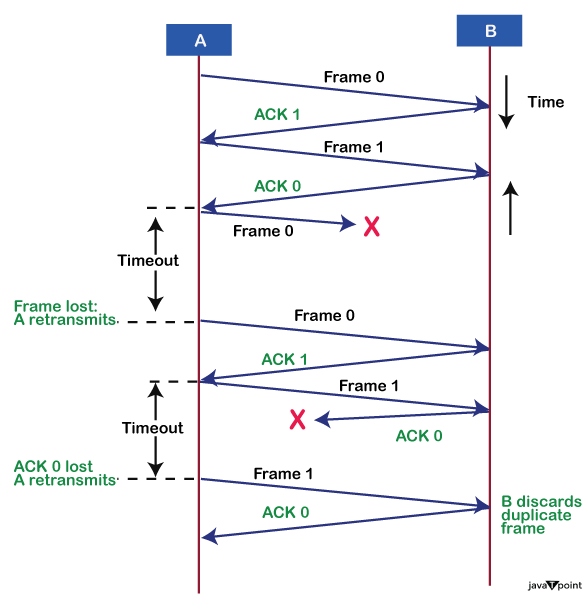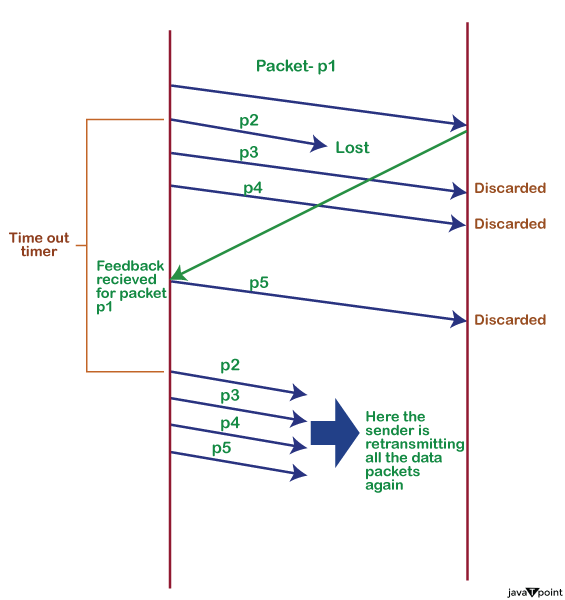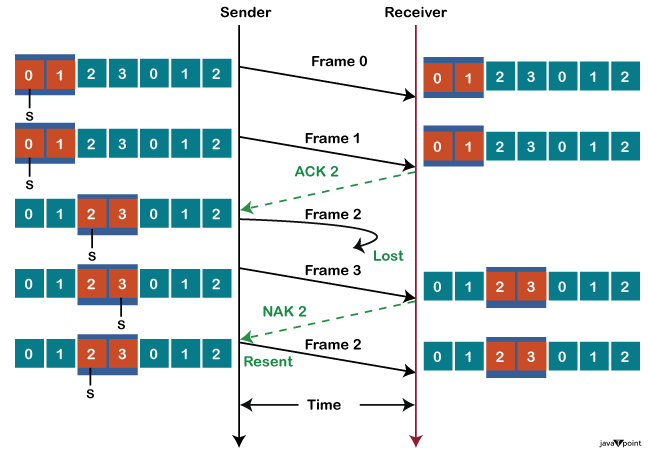Noisy Channel protocolsA Noisy Channel Protocol is a sort of conversation protocol that is used in communique structures where the transmission channel may additionally introduce mistakes into the transmitted facts. This sort of protocol is designed to cope with mistakes in the communication channel and make sure that the statistics being transmitted are received appropriately when the receiver gives up. The important goal of Noisy Channel Protocols is to minimize the error rate in the transmitted data through techniques including blunders detection and correction, go with the flow manipulation, and retransmission of misplaced or corrupted facts frames. Some examples of Noisy Channel Protocols encompass the Stop-and-Wait Protocol, the Sliding Window Protocol, and the Automatic Repeat Request (ARQ) Protocol. STOP-AND-WAIT ARQ Protocol - The Stop and Wait protocol is a protocol used for dependable records transmission over a noisy channel. In this protocol, the sender simplest sends one frame at a time and waits for an acknowledgment (ACK) from the receiver earlier than sending the subsequent frame. This facilitates making certain that the receiver gets the data efficiently and gets rid of the want for retransmission within the case of mistakes as a result of the noisy channel. The sender continuously video displays the channel for mistakes, and if a blunders is detected, it waits for the next ACK before resending the body. This protocol adds blunders manipulated to the basic unidirectional communique of statistics frames and ACK frames within the opposite route. Flow DiagramA statistics glide diagram in the Stop-and-Wait protocol in a loud channel may be used to describe the go with the flow of information between the sender and the receiver. This diagram generally includes the following components: 
Sender: The sender sends facts frames one after the other, and waits for a reaction (ACK or NACK) from the receiver before sending the following records body. Receiver: The receiver receives the recorded frames and approaches them. If the frame is acquired efficiently, the receiver sends an ACK signal to the sender. If the body is not obtained effectively, the receiver sends a NACK sign to the sender. Noisy Channel: The noisy channel is the medium through which the information frames are transmitted from the sender to the receiver. The channel can upload noise to the data frames, resulting in errors and corruption of the information. Error Detection: The receiver uses errors detection strategies such as checksums to locate errors within the acquired statistics frames. Error Correction: If a blunders is detected, the receiver sends a NACK sign to the sender, requesting a retransmission of the body. In this protocol, the sender simplest sends one data frame at a time and waits for a response from the receiver before sending the next frame. This ensures that the receiver has enough time to system each frame before receiving the subsequent one. The Stop-and-Wait protocol is reliable, however has low throughput compared to different protocols. 2. GO-BACK-N ARQ Protocol - The Go-Back-N Automatic Repeat Request (ARQ) protocol is a form of error-manipulate protocol used in data verbal exchange to ensure reliable delivery of records over a loud channel. In a noisy channel, the possibility of mistakes inside the obtained packets is excessive, and hence, there is a desire for a mechanism to hit upon and accurately identify those errors. The Go-Back-N ARQ protocol is a kind of sliding window protocol wherein the sender transmits a window of packets to the receiver, and the receiver sends lower back an acknowledgment (ACK) to the sender indicating a receipt of the packets. In case the sender does now not receive an ACK inside a targeted timeout period, it retransmits the whole window of packets. Flow DiagramThe waft diagram that illustrates the operation of the Go-Back-N ARQ protocol in a noisy channel: 
Sender Side:
Receiver Side:
Sender Side (in case of no ACK acquired):
Sender Side (in case of NAK acquired):
The above steps are repeated till all packets have been correctly obtained with the aid of the receiver. The Go-Back-N ARQ protocol provides a dependable mechanism for transmitting information over a noisy channel whilst minimizing the number of retransmissions required. The above steps are repeated till all packets have been correctly obtained with the aid of the receiver. The Go-Back-N ARQ protocol provides a dependable mechanism for transmitting information over a noisy channel whilst minimizing the number of retransmissions required. 3. SELECTIVE REPEAT ARQ Protocol - The Selective Repeat ARQ protocol is a sort of mistakes-manipulate protocol utilized in fact communique to ensure reliable delivery of data over a noisy channel. Unlike the Go-Back-N ARQ protocol which retransmits the whole window of packets, the Selective Repeat ARQ protocol retransmits only the packets that had been now not correctly acquired. In the Selective Repeat ARQ protocol, the sender transmits a window of packets to the receiver, and the receiver sends lower back an acknowledgment (ACK) to the sender indicating a successful receipt of the packets. If the receiver detects any blunders in a packet, it sends a bad acknowledgement (NAK) to the sender requesting retransmission of that packet. In the Selective Repeat ARQ protocol, the sender keeps a timer for each packet within the window. If the sender does not get hold of an ACK for a packet before its timer expires, the sender retransmits handiest that packet. At the receiver aspect, if a packet is received efficiently, the receiver sends lower back an ACK with the sequence quantity of the following anticipated packet. However, if a packet is obtained with mistakes, the receiver discards the packet and returns a NAK with the sequence variety of the packet that desires to be retransmitted. Unlike Go-Back-N ARQ, in Selective Repeat ARQ, the receiver buffer is maintained for all packets that aren't in series. When a packet with a chain quantity exclusive from the predicted collection wide variety arrives at the receiver, it's miles buffered, and the receiver sends an ACK for the final in-order packet it has received. If a packet with a series range that the receiver has already buffered arrives, it's far discarded, and the receiver sends an ACK for the closing in-order packet it has obtained. In summary, the Selective Repeat ARQ protocol offers a reliable mechanism for transmitting records over a loud channel whilst minimizing the quantity of retransmissions required. It retransmits simplest the packets that had been now not effectively acquired and buffers packets that arrive out of order to reduce the variety of retransmissions required. Flow DiagramThe drift diagram that illustrates the operation of the Selective Repeat ARQ protocol in a noisy channel: 
Sender Side:
Receiver Side:
Sender Side (in case of no ACK acquired):
The above steps are repeated till all packets have been successfully obtained through the receiver. The Selective Repeat ARQ protocol provides a dependable mechanism for transmitting statistics over a noisy channel whilst minimizing the range of retransmissions required. It retransmits simplest the packets that have not been efficiently acquired, and buffers out-of-order packets to reduce the wide variety of retransmissions required. |
 For Videos Join Our Youtube Channel: Join Now
For Videos Join Our Youtube Channel: Join Now
Feedback
- Send your Feedback to [email protected]
Help Others, Please Share










